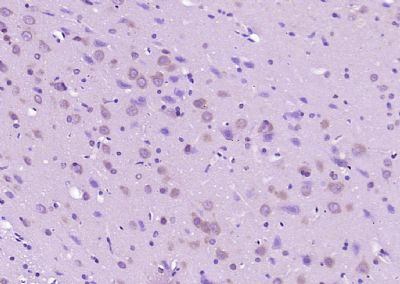APC10 Polyclonal Antibody
Purified Rabbit Polyclonal Antibody (Pab)
- SPECIFICATION
- CITATIONS
- PROTOCOLS
- BACKGROUND

Application
| WB, IHC-P, IHC-F, IF, ICC, E |
|---|---|
| Primary Accession | Q9UM13 |
| Reactivity | Rat, Pig, Bovine |
| Host | Rabbit |
| Clonality | Polyclonal |
| Calculated MW | 21 KDa |
| Physical State | Liquid |
| Immunogen | KLH conjugated synthetic peptide derived from human APC10 |
| Epitope Specificity | 31-130/185 |
| Isotype | IgG |
| Purity | affinity purified by Protein A |
| Buffer | 0.01M TBS (pH7.4) with 1% BSA, 0.02% Proclin300 and 50% Glycerol. |
| SIMILARITY | Belongs to the APC10 family. Contains 1 DOC domain. |
| SUBUNIT | The APC/C is composed of at least 12 subunits. The C-terminus of APC10 binds to CDC27/APC3. |
| Important Note | This product as supplied is intended for research use only, not for use in human, therapeutic or diagnostic applications. |
| Background Descriptions | Composed of more than ten subunits, the anaphase-promoting complex (APC) acts in a cell-cycle dependent manner to promote the separation of sister chromatids during the transition between metaphase and anaphase in mitosis. APC, or cyclosome, accomplishes this progression through the ubiquitination of mitotic cyclins and other regulatory proteins that are targeted for destruction during cell division. APC is phosphorylated, and thus activated, by protein kinases Cdk1/cyclin B and polo-like kinase (Plk). APC is under tight control by a number of regulatory factors, including CDC20, CDH1 and MAD2. Specifically, CDC20 and CDH1 directly bind to and activate the cyclin-ubiquitination activity of APCs. In contrast, MAD2 inhibits APC by forming a ternary complex with CDC20 and APC, thus preventing APC activation. APC10 contains a Doc1 homology domain, which is a beta-sandwich structure common to many other putative E3 ubiquitin ligases. APC10 binds to core APC subunits throughout the cell cycle. Specifically, APC10 binds to the C-terminus of CDC27/APC3. During mitosis, APC10 is localized in centrosomes and mitotic spindles. APC10 also localizes to kinetochores from prophase to anaphase, and to the midbody in telophase and cytokinesis. |
| Gene ID | 10393 |
|---|---|
| Other Names | Anaphase-promoting complex subunit 10, APC10, Cyclosome subunit 10, ANAPC10, APC10 |
| Dilution | WB=1:500-2000,IHC-P=1:100-500,IHC-F=1:100-500,ICC=1:100-500,IF=1:100-500,ELISA=1:5000-10000 |
| Storage | Store at -20 ℃ for one year. Avoid repeated freeze/thaw cycles. When reconstituted in sterile pH 7.4 0.01M PBS or diluent of antibody the antibody is stable for at least two weeks at 2-4 ℃. |
| Name | ANAPC10 |
|---|---|
| Synonyms | APC10 |
| Function | Component of the anaphase promoting complex/cyclosome (APC/C), a cell cycle-regulated E3 ubiquitin ligase that controls progression through mitosis and the G1 phase of the cell cycle (PubMed:18485873). The APC/C complex acts by mediating ubiquitination and subsequent degradation of target proteins: it mainly mediates the formation of 'Lys-11'-linked polyubiquitin chains and, to a lower extent, the formation of 'Lys-48'- and 'Lys-63'-linked polyubiquitin chains (PubMed:18485873). The APC/C complex catalyzes assembly of branched 'Lys-11'-/'Lys-48'-linked branched ubiquitin chains on target proteins (PubMed:29033132). |

Thousands of laboratories across the world have published research that depended on the performance of antibodies from Abcepta to advance their research. Check out links to articles that cite our products in major peer-reviewed journals, organized by research category.
info@abcepta.com, and receive a free "I Love Antibodies" mug.
Provided below are standard protocols that you may find useful for product applications.
If you have used an Abcepta product and would like to share how it has performed, please click on the "Submit Review" button and provide the requested information. Our staff will examine and post your review and contact you if needed.
If you have any additional inquiries please email technical services at tech@abcepta.com.













 Foundational characteristics of cancer include proliferation, angiogenesis, migration, evasion of apoptosis, and cellular immortality. Find key markers for these cellular processes and antibodies to detect them.
Foundational characteristics of cancer include proliferation, angiogenesis, migration, evasion of apoptosis, and cellular immortality. Find key markers for these cellular processes and antibodies to detect them. The SUMOplot™ Analysis Program predicts and scores sumoylation sites in your protein. SUMOylation is a post-translational modification involved in various cellular processes, such as nuclear-cytosolic transport, transcriptional regulation, apoptosis, protein stability, response to stress, and progression through the cell cycle.
The SUMOplot™ Analysis Program predicts and scores sumoylation sites in your protein. SUMOylation is a post-translational modification involved in various cellular processes, such as nuclear-cytosolic transport, transcriptional regulation, apoptosis, protein stability, response to stress, and progression through the cell cycle. The Autophagy Receptor Motif Plotter predicts and scores autophagy receptor binding sites in your protein. Identifying proteins connected to this pathway is critical to understanding the role of autophagy in physiological as well as pathological processes such as development, differentiation, neurodegenerative diseases, stress, infection, and cancer.
The Autophagy Receptor Motif Plotter predicts and scores autophagy receptor binding sites in your protein. Identifying proteins connected to this pathway is critical to understanding the role of autophagy in physiological as well as pathological processes such as development, differentiation, neurodegenerative diseases, stress, infection, and cancer.


